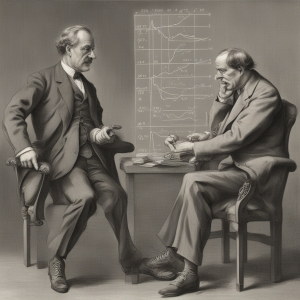Introduction to Pairs Trading
The world of financial trading offers a plethora of strategies designed to help traders make informed decisions. One such technique, frequently used by hedge funds and investment gurus, is Pairs Trading. In the simplest terms, Pairs Trading is a strategy that involves trading two securities simultaneously. This strategy relies on price discrepancies between these two securities.
So, why should you, as an individual trader or investor, consider incorporating Pairs Trading into your investment toolbox? With its focus on balancing risk and looking for stability rather than immediate high returns, Pairs Trading offers a unique approach to trading. It is a technique that promotes strategic thinking, offering a different perspective compared to traditional trading methods.
Understanding the fundamentals of Pairs Trading, its benefits, how to identify suitable pairs, and techniques for executing successful trades can provide an edge in the market. More importantly, it can help manage risk, a vital aspect of trading in the volatile world of cryptocurrencies. In the following sections, we delve deeper into the world of Pairs Trading, honing in on some key methods and best practices to equip you with the knowledge needed to profit from price discrepancies.
What is Pairs Trading?
Pairs Trading is a market-neutral trading strategy that matches a long position with a short position in a pair of highly correlated instruments such as two stocks, exchange-traded funds (ETFs), currencies, commodities or options. Traders use this strategy to hedge their risk while taking advantage of price discrepancies between the two.
In coinage with the term 'market-neutral strategy', Pairs Trading doesn't rely on the overall direction of the market. Instead, it hones in on the relative performance of two instruments. This approach provides robustness during market volatilities, thus enabling traders to benefit regardless of market conditions. The profit arises from the price discrepancy between the two correlated pairs when the "gap" between them closes.
The cornerstone of Pairs Trading lies in the notion of mean reversion; it assumes that the price ratio of the two instruments involved will revert to its average over time. Hence, when the two securities drift apart, i.e., when one is perceived as overpriced while the other underpriced, a trading opportunity is birthed.
To successfully implement this trading strategy, it's crucial to identify pairs of securities that are highly correlated. Additionally, proficiency in technical analysis to forecast market trends is invaluable—clearly highlighting why Pairs Trading is popular among seasoned traders and financial institutions.
Advantages and Disadvantages of Pairs Trading Strategy
| Pros | Cons |
|---|---|
| Market neutrality - Pairs trading is a market-neutral trading strategy | Complexity - Determining correlating pairs could be difficult |
| Reduced risk - Risk is minimized as the strategy involves taking both long and short positions | Requires comprehensive knowledge - Successful trading requires a deep understanding of the market |
| Profitability in various market situations - Pairs trading can be profitable in different market conditions, whether it's bull, bear or sideways market | Potential of pair decoupling - The two chosen stocks could decouple leading to potential losses |
| Flexibility - Diverse opportunities, as any pair of stocks can be used for trading | Time-consuming - Requires constant monitoring of market conditions for the pairs |
How Pairs Trading Works

To elucidate the intricate workings of Pairs Trading, imagine two stocks - A and B that have a high correlation. When observance over time highlights a substantial price gap between them, Pairs Trading comes into play.
In essence, the trader would go long on the underperforming stock (A) and short on the over-performing one (B). The expectation is that stock A will increase in value, while stock B will decrease, closing the price gap. The term 'long' refers to buying a security in anticipation of a price increase, while 'short' means selling a borrowed security expecting its price to drop, allowing you to buy it back at a lower price.
Once the prices revert to their mean and the gap between both stocks closes, the trader will then close both positions, reaping a profit from the price discrepancy that once existed. The profit is essentially the combined profit from the long position and the short position.
It's essential to bear in mind that while the strategy is simple in theory, the execution requires a deep understanding of market analysis and trends. The key lies in identifying suitable, highly correlated pairs and acting fast enough to exploit the price discrepancies before they close.
Key Elements of Pairs Trading Strategies
Underpinning every successful Pairs Trading strategy are certain key elements. Condensed into four critical components, here's what you need to consider:
Finding the Right Pair

The first and fundamental step in Pairs Trading is to find two securities that move together - their prices go up and down in harmony. These pairs often come from the same sector or industry, such as two tech companies or two oil enterprises. Correlation can be visually observed through a scatter plot, or a correlation coefficient, a measure of how closely two variables move together, can be calculated.
Identifying a Discrepancy
Once a pair is identified, the next step is to look for a divergence or discrepancy in their price movements. This discrepancy could arise from various ever-evolving market factors such as shifts in the economy, company-specific news or events, trading volumes, or even changes in investor sentiment. Traders usually rely on technical indicators to identify these discrepancies.
Setting the Entry and Exit Points

In Pairs Trading, it's crucial to determine when to enter or exit a position. This decision largely depends on the trader's expectation of when the prices will revert to the mean. An entry point is when the price difference is sufficiently large for the trader to believe that reversion to the mean will soon occur, and an exit point is when the prices have reverted to the mean. Typically, traders also set stop-loss points to manage potential losses if the trade doesn't go as expected.
Managing Risk
Like any trading strategy, Pairs Trading is not without risks. Though described as market-neutral, it’s not completely immune from market trends. Also, there's the risk of the price ratio not reverting to its historical mean. To mitigate these risks, traders often diversify their portfolio and use other risk management strategies such as stop-loss orders and position sizing.
In conclusion, Pairs Trading offers a potential way to hedge risk and generate profits from price discrepancies. However, it requires careful pairs selection, technical analysis proficiency, and a solid understanding of market factors that can affect price movements. Additionally, it is advisable to keep a close eye on market trends and have a robust exit strategy in place.
Implementing a Successful Pairs Trading Strategy
Fret not if you feel overwhelmed about implementing a Pairs Trading Strategy. Here's an easy guide that can help refine your actions.
The first step is to select a suitable pair of assets. These could be cryptocurrencies or stocks that have displayed a high historical correlation. Analytical tools, such as a correlation matrix, can aid in this selection by offering easy-to-understand insights into potential pairs.
Next, continuously monitor the price ratio of your chosen asset pair. This active tracking allows you to identify any deviations from the norm, thus signaling a potential trading opportunity. Graphic tools such as scatter plots and line graphs can serve as effective means to visualize these price changes over time.
Once a deviation is identified, validate your analysis by employing statistical means. For instance, use techniques to check if the amounts deviate beyond a certain standard deviation.
Upon confirming the discrepancy, plan your trades. As part of this, you should set a target price which would be the signal for you to exit the positions, leveraging regularity of the mean reversion theory.
Execution involves placing the trades simultaneously. One asset should be short-sold, expecting its overpriced nature to correct, while the other should be purchased in anticipation of an upward price correction.
Remember, continuous monitoring post the trades is equally crucial. It helps you identify the opportune moment to exit the trading positions, which is typically when the divergence close or reduce substantially.
In sum, the implementation of a successful Pairs Trading Strategy is a systematic process that involves meticulous tracking and strategic execution. It necessitates a deep statistical understanding, discipline, and patience.
Risks and Rewards of Pairs Trading
Like any trading strategy, Pairs Trading presents a blend of potential rewards and inherent risks. Understanding these is paramount for strategizing effectively and managing your investment portfolio wisely.
The Rewards
The most appealing aspect of Pairs Trading is its market-neutral nature. This strategy is less concerned with the general ups and downs of the market and more focused on the relative performance of two instruments. Thus, it can provide steady returns even under volatile market conditions.
Secondly, the use of both long and short positions offers traders a hedge against potential losses. In case the market moves against your expectations, the losses from one instrument can potentially be offset by gains from the other. This reduces overall risk, making Pairs Trading a safer option compared to conventional trading methods.
The Risks
On the flip side, Pairs Trading does not come without risks. The most glaring is the threat of one security not reverting to the mean as predicted - a situation referred to as 'divergence risk'. The risk arises when the correlation between the two securities breaks down, and they start moving in opposite directions from the anticipated trend.
Another significant risk is the execution of trades. Actively managing and monitoring trades, especially with complex orders and contingent trades, can prove to be challenging, even for seasoned traders. The demand for quick actions, rigorous market analysis, and steady nerves can make Pairs Trading a daunting undertaking, particularly for beginners.
Therefore, ample preparation, mindful analysis, and a well-planned exit strategy are imperative when engaging in Pairs Trading. It's essential to maintain a well-diversified portfolio and not rely solely on Pairs Trading as a risk management strategy.
Understanding Price Discrepancies
At the core of Pairs Trading lies the term 'price discrepancies'. But what's behind this concept You might ask. Price discrepancies occur when the prices of two highly correlated securities begin to divert from their usual path. Market factors such as changes in supply and demand, market sentiment, or news events can create such a divergence. This divergence can be temporary or longer-lasting, but the crux of a pairs trading strategy is the assumption that this gap will eventually close.
Detecting price discrepancies requires a keen eye for detail and a solid understanding of both the securities you are trading and the market conditions. Traders may use technical indicators, statistical tools, automated systems, or even a good old-fashioned gut feeling to identify price discrepancies.
The idea is to catch the discrepancy early, before market forces push the prices back together. Although price discrepancies can open the door to significant profit opportunities, it’s also essential to note that, as with all trading strategies, there is a risk involved. Not all price discrepancies will close in the expected timeframe, and staying alert to market trends and potential pitfalls is key to executing a successful pairs trading strategy.
Utilizing Price Discrepancies for Profit
Once you’ve identified a discrepancy between your chosen pair, the next stage in the Pairs Trading strategy is to utilize this for profit. Here's how:
To capitalize on the price discrepancy, you would take a short position on the overpriced security and a long position on the underpriced one. By doing this, you're naturally hedging your risk, since a downward movement in one security would typically be offset by an upward movement in the other.
You should monitor the price movements closely, as the goal is for the price discrepancy to close. When it does, you can exit both positions. Specifically, you would buy back the security you sold short (ideally at a lower price), and sell the security you bought (ideally at a higher price).
Within this part of the strategy, it is important to keep in mind that while the possibility of profit is enticing, the risk of the price discrepancy not closing or getting wider still exists. Consequently, managing risk is essential.
Pairs Trading is not about rapid, high returns; instead, it is about consistency and risk management. This strategy often results in small but frequent gains. However, these consistent gains quickly add up, enabling traders to realize substantial profits over time.
Conclusion on Pairs Trading Strategies
In the vast world of financial trading, Pairs Trading stands out as a method that encourages a careful balancing act. Rather than focusing on immediate, high-risk gains, this strategy promotes seeking stability through exploiting price discrepancies between two highly correlated pairs. In a volatile marketplace, this approach lends resilience, making it appealing to both institutional investors and individual traders.
However, success in Pairs Trading requires not just understanding the strategy, but also the ability to conduct robust market analysis. Effectively identifying suitable pairs, monitoring price movement for discrepancies, and executing trades at the right time are all crucial. This strategy is, therefore, undoubtedly complex and necessitates both comprehensive knowledge and keen financial acuity.
Nevertheless, for those willing to delve into the complexity and acquire the required expertise, Pairs Trading represents a powerful tool. It offers the opportunity for profit, irrespective of the broader market trend, while also providing an effective hedge against the financial turbulence synonymous with cryptocurrency trading.
In essence, understanding and employing Pairs Trading strategies can assist in not just surviving, but thriving within the financial trading world by unlocking opportunities to profit from price discrepancies.
Understanding Pairs Trading and Its Profitability
What is Pairs Trading?
Pairs Trading is a market-neutral trading strategy that matches a long position with a short position in a pair of highly correlated instruments such as two stocks, exchange-traded funds (ETFs), currencies, commodities or options.
What does it mean by 'Profiting from Price Discrepancies' in Pairs Trading?
In Pairs Trading, the 'Price Discrepancies' between the two instruments (stocks, ETFs, etc.) are exploited for profit. This means when one instrument's price goes up and the other goes down, the discrepancy is used to make profits.
How to Select Stocks for Pairs Trading?
Pairs are typically selected from within the same industry, and hold some form of economic similarity. Pairs are chosen on the basis of their historic correlation and cointegration properties.
What are the Risks of Pairs Trading?
Pairs trading carries several risks including the potential for incorrect pair selection or poorly executed trades, economic changes that can affect correlations, the potential for one security in the pair to be halted or to go bankrupt, and the potential for wide bid-ask spreads.
What is needed to Start Pairs Trading?
To start pairs trading, you need a brokerage account with access to trading a wide range of assets. You also need statistical software to conduct correlation and cointegration tests, and a decent understanding of the financial markets and technical analysis.







